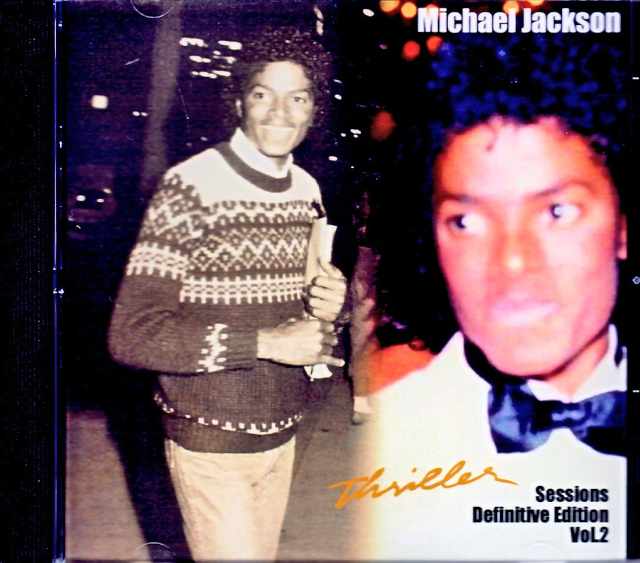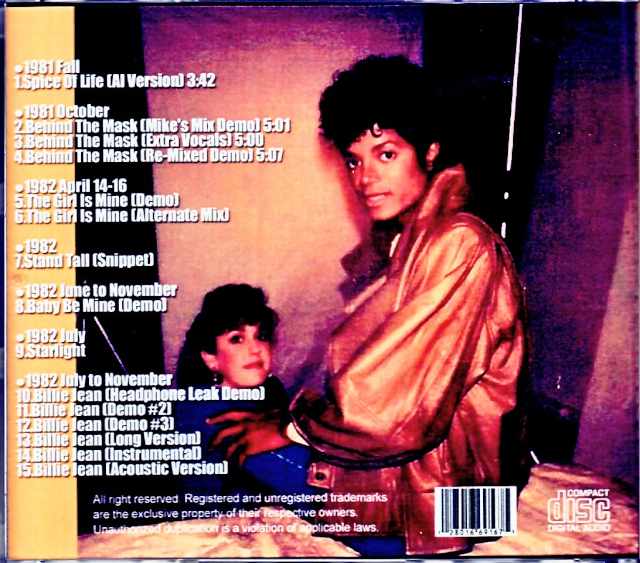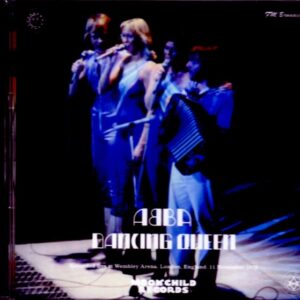Description
We will examine how the monster album “Thriller” was made by arranging Michael Jackson’s demos, alternate versions, and unreleased songs in chronological order as much as possible. This is the second installment. The second half of the previous installment included songs recorded in the “Thriller” sessions in the fall of 1981. In fact, there are other songs recorded in the fall of 1981. First, “Learned My Lesson”. The recording from that time has not been leaked. It was picked up again during the HIStory sessions. Bruce Swedien mixed it in April 1994 and recorded it in full, but it was not included in the album (there is a snippet, but it is not included this time because it is from a different time). Then, the title was changed to “Much Too Soon” and it was included in “Michael” in 2010 with a different mix. “Nymphette Lover” has also not been leaked, only the title. And “Rolling Dice”. This song was written by Rod Temperton and produced by Quincy Jones, but this has not been leaked either. In a testimony in Mexico in 1993, Michael acknowledged the song’s existence. “Yes, we did a demo at Hayvenhurst but we didn’t release it. We thought it wasn’t strong enough.” It’s likely that this song was abandoned at an early stage, but it’s believed to have been recorded. Other songs written by Rod that didn’t go beyond the demo stage (apart from songs offered to other artists) include “Got The Hots” and “Starlight,” which progressed to a certain extent and turned into a great song. And “Spice Of Life.” It’s a Manhattan Transfer song, and it was included on the album “Bodies And Souls” released in September 1983. It was written by Rod Temperton and Derek Bramble, a member of Heat Wave, where Rod was. According to Derek, Michael recorded this song, which is thought to have been in the fall of 1981. The version sung by Michael has not been leaked, but an AI-recreated version of “Spice Of Life” is included at the beginning. “Behind The Mask” was recorded in the fall of 1981. To be precise, it was recorded in October 1981 (though some say it was considered for recording in 1980). It is a cover of an instrumental song by Yellow Magic Orchestra, but producer Quincy Jones, who heard it during a visit to Japan, introduced it to Michael. Michael then created a reconstructed version with a melody and additional lyrics. Co-writer and lyricist Chris Mosdell said, “Michael made it a love song about a woman. It was a completely different premise for me… but, well, I left it to him.” It was not included on Thriller because writer Sakamoto, Mosdell, and Michael could not reach an agreement on royalties (Michael demanded 100% of the publishing rights be transferred to Sakamoto, and Sakamoto’s side requested that they check how much he had changed, but Michael refused). The version to which Michael added his vocals is “Behind The Mask (Mike’s Mix (Demo)”. Even if it’s a bit of an exaggeration to say that 100% of the publishing rights have been transferred, this is a wonderful Michael-stamped work that makes it hard to believe that the original was an instrumental, and makes you believe that Michael’s vocals were already in the original. It was later included on Greg Phillinganes’ album “Pulse” and Eric Clapton’s “August”, but the credits on that album are Ryuichi Sakamoto, Chris Mosdell, and Michael Jackson, which means that they were offered Michael’s version by Michael’s side. Eric and Greg’s singing is not bad, but it’s definitely Michael. The version included on “Michael” in 2010 was completely reworked by John McClain, with verse 2 replaced by verse 3 and including a saxophone solo. This time, it is almost the same as the “Michael” version, with a pseudo-live arrangement, but it also includes “Behind The Mask (Extra Vocals)”, which has additional vocals (it’s unclear whether they are reused from “Mike’s Mix”). “Mike’s Mix (Demo)” had some quality and mixing issues, and the sampling from the “YMO” version was actually ripped from a record (you can hear the needle noise). There were also some errors in the vocal mixing, and the sound pressure was too strong. (Re-Mixed Demo) was the result of correcting and remixing those. Full-scale recording of the album “Thriller” began on April 14, 1982 at Westlake Recording Studios in Los Angeles, California. The production budget was $750,000. Michael wrote songs and recorded his vocals directly onto an audio recorder, and then he used that and sang from memory to record demos on 16 tracks at Hayvenhurst. Members of Toto were also among the recording staff. “The Girl Is Mine”, the first completed recording of a song from “Thriller”, was written and co-produced by Michael Jackson (produced by Quincy Jones). Paul McCartney was not involved in the composition of the song, but participated as a guest vocalist. Recorded at Westlake Studios from April 14th to 16th, 1982, and released as the first single from the album on October 18th of the same year. This is considered the last collaboration between Michael and Paul (although Michael did further recording of “The Man” in February 1983, so it is more likely that this was the last). “The Girl Is Mine” was written by Michael while watching cartoons with Paul. Quincy Jones initially asked Michael to write a song about two men fighting over one woman. Inspired, Michael woke up in the middle of the night and recorded his voice into a tape recorder. He later said, “I sang what I heard in my head: the melody, the keyboards, the strings. So I recorded the whole song on tape.” Quincy then asked him to add a spoken verse in the second half. Michael and Paul recorded the song at Westlake Studios in Los Angeles from April 14th to 16th, 1982. Michael said that this recording was one of his most enjoyable moments in the studio. “One of my favorite songs that I’ve recorded as a solo artist is probably “The Girl Is Mine” because working with Paul McCartney was so exciting, literally so much fun. We were talking, playing, throwing things at each other, joking around. We actually recorded the (instrumental) track and the vocals live almost at the same time. I have the footage, but I haven’t released it yet. Maybe one day I’ll give you a sneak preview.” Footage of the two was later released on the Paul McCartney World Tour. Several members of the band Toto participated in the recording, including David Paich (piano), Jeff Porcaro (drums), Steve Lukather (guitar), and Steve Porcaro (synthesizer programming). We’ve recorded a demo of Michael singing solo on “The Girl Is Mine.” Michael sings all the parts sung by both Michael and Paul, and it’s clear that Michael wrote both the lyrics and the music for this song. There are some lyrics that can only be heard here, but instead, Michael and Paul are not yet able to talk about fighting over the girl. This is the verse that Quincy later asked Michael to write. In the end, the girl fell in love with Michael and said she couldn’t love anyone else, and Paul said he couldn’t believe it, which makes you think that Michael got the girl. We also included the alternate mix that was included on the American promo single for “The Girl Is Mine.” There is also “Set It On Out” recorded in 1982, but it is an unleaked song with only the title known. “MJ Melody” was also recorded in the same period, but it has not been leaked, and it may have been a tentative title and an instrumental. And “Stand Tall”. This is said to have been composed by Michael in 1982. However, according to fan and researcher Damien Shields, Michael never recorded this song, and the recording he heard only had the chorus and bridge, no verse, and it was sung by a male session singer, not Michael. The vocal recording has not been leaked, but there is an instrumental snippet, which I included. It was copyrighted in 1985 and is said to be an unreleased song from the Bad sessions. The sound is similar to “State of Shock,” recorded in May and June 1983, so to be honest, the timing is unclear. “Baby Be Mine” was written by Rod Temperton and recorded in June 1982 (completed in November 1982). In the midst of the backlash against disco music at the time, Michael recorded a song that was in a sense very “Off The Wall”-like at a relatively early stage, in order to make an album that was better than “Off The Wall.” To be honest, I think it is a better dancer than any song on “Off The Wall.” It is actually the second song on the album, which is an important position, but it was not released as a single and was not performed at live shows. A 30-second snippet was leaked at first, but then a complete demo was leaked, and this is what I included. It is probably an early demo, recorded around June. To be honest, Michael’s vocals are not as settled as in the album version, and it feels like he is searching for something. In July 1982, “Starlight” was recorded, written by Rod Temperton. “Starlight” was written with the concept of expressing Michael’s love of movies and his growing up. “We need stars and sunshine, all you can do is be by my side, and your life will begin.” There is no cinematic quality to it. And although it is a love song, it makes me want to think of me as Quincy Jones and you as Michael Jackson. That’s what growing up means. Quincy thought this song should have been the title track of the album, but still thought the title itself was weak. “Billie Jean” was written by Michael Jackson and released as the second single on January 2, 1983. It is considered one of the greatest and most legendary songs Michael released, due to its timelessness and the introduction of the moonwalk during his performance at Motown 25. The single was a huge success, receiving numerous accolades and cementing Michael as an international icon across the pop world. An extended 12″ version was released.This version has a longer intro and outro, and the track ends with an ad-lib “You know you ain’t (Not my lover) / You know you can’t (Not my lover)”. This would eventually be reused in live performances of the song. This was also originally intended to be on the album, but was ultimately cut as it didn’t fit into the album’s length. Here we have the long version on the 12″ and an instrumental version of the same length (with Michael’s vocals). “Billie Jean” was a collaboration with Quincy Jones. It was first recorded as a demo at Hayvenhurst in the fall of ’81, and appears on Vol. 1. It was then recorded again at Westlake with Quincy from July to November ’82. Originally, Quincy didn’t like the song and thought it should be scrapped. He felt the song was too weak, didn’t like the intro, and wanted to change the title to “Not My Lover”. Michael reportedly didn’t speak to Quincy about this for days. Audio engineer Bruce Swedien mixed “Billie Jean” 91 times. The mix from the second mix was ultimately selected. This time, there is a 5-minute demo with poor sound quality that leaked from the headphones, and Demo #2, which is a trial demo that is just under a minute longer than the Long Version, with a simple development in the middle, and has been remastered for sound levels. And Demo #3, which has a very raw vocal, although it ends in a mess. And there is also an Acoustic Version, which is likely to be fan-made. The music video for “Billie Jean” was refused broadcast on MTV because it did not meet the standards. However, Walter Yetnikoff, who was the president of CBS Records at the time, threatened MTV executives that he would make public MTV’s stance on racism, and as a result MTV accepted Yetnikoff’s request and it was broadcast on MTV. “I told MTV, ‘I’m taking everything we have off the air, all of our product. I’m not giving you any more videos. And I’m going to go out there and tell everybody that I don’t want to play any black people’s songs.'” -Walter Yetnikoff, Blender, October 2005 The music video premiered on March 10, 1983, making Jackson the first black artist to receive regular airtime on MTV. It’s also said that the video boosted sales of Thriller by 10 million copies. Michael has played “Billie Jean” on every tour since the Jacksons’ Victory Tour. For each performance, Michael wore a sparkly black jacket, one white glove, white socks, and a fedora. “I just thought one glove was better than two. I like to accentuate my movements. The audience’s eyes go to the white, which is the gloves. And when I’m dancing, if there’s a little bit of light on my feet, they scream in amazement at my movements. That’s why I wear white socks. For the jacket design, I sat down with the people who made the clothes and told them where I wanted the buttons, the buckles, the designs.” The first and most iconic performance of “Billie Jean” took place on May 16, 1983, when Michael appeared on the Motown 25: Yesterday, Today, Forever TV special. Michael initially declined to perform with his brothers because he wanted to distance himself from the band and Motown and focus on his solo career. After talking with Berry Gordy (Motown founder and Rockwell’s father), he agreed to perform if he was allowed to perform “Billie Jean.” This performance debuted some of Michael’s most iconic moves, including the moonwalk (a dance technique also known as the backslide, which is said to have originated from Cab Calloway’s The Buzz in the 1930s) and the toestand, which would become Michael’s trademark dance style. The special was watched by 50 million people and earned Michael an Emmy nomination. Despite the show’s huge success, Michael was actually very embarrassed by the performance. Later, during the recording sessions for “We Are The World,” Michael went up to Daryl Hall of Hall & Oates and said, “Hey, I hope it’s alright, but I stole “No Can Do” for “Billie Jean.” 1981 Fall 1.Spice Of Life (AI Version) 3:42 1981 October 2.Behind The Mask (Mike’s Mix Demo) 5:01 3.Behind The Mask (Extra Vocals) 5:00 4.Behind The Mask (Re-Mixed Demo) 5:07 1982 April 14-16 5.The Girl Is Mine (Demo) 6.The Girl Is Mine (Alternate Mix) 1982 7.Stand Tall (Snippet) 1982 June to November 8.Baby Be Mine (Demo) 1982 July 9.Starlight 1982 July to November 10.Billie Jean (Headphone Leak Demo) 11.Billie Jean (Demo #2) 12.Billie Jean (Demo #3) 13.Billie Jean (Long Version) 14.Billie Jean (Instrumental) 15.Billie Jean (Acoustic Version)







Reviews
There are no reviews yet.